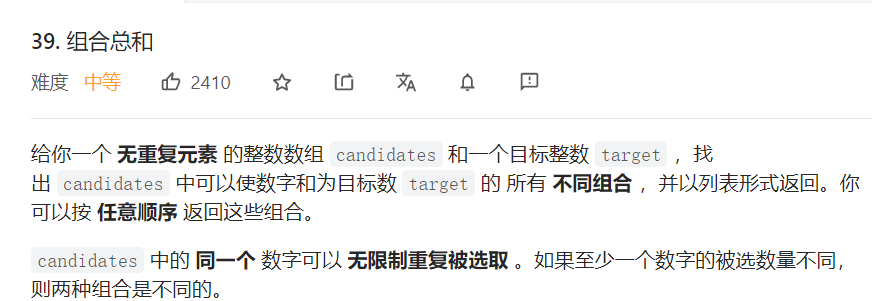回溯算法是什么,感兴趣可以看我上一篇文章:https://blog.youkuaiyun.com/m0_62515800/article/details/129732513
回溯算法的基本思想:
适用:求搜索问题和优化问题,且要满足多米诺性质
搜索空间:树,结点对应部分解向量,可行解在树叶上
搜索过程:采用系统的方法隐含遍历搜索树
搜索策略:深度优先,宽度优先,函数优先,宽深结合等
结点分支判定条件:满足约束条件--分支扩张解向量;不满足分支条件--回溯到该结点的父结点
存储:当前路径
回溯算法的常见类型:
子集类型

其实这类型题目有两个思路:用path[i]来存储路径
a.枚举第i步选择还是不选择这个字母加入路径
class Solution {
List<List<Integer>> re= new ArrayList<>();
public List<List<Integer>> subsets(int[] nums) {
List<Integer> one=new ArrayList<>();
dfs(nums,0,one);
return re;
}
private void dfs(int[] nums,int idx, List<Integer> one){
if(idx==nums.length){
re.add(new ArrayList<>(one));
return;
}
//nums[idx]不加入子集
dfs(nums,idx+1,one);
//nums[idx]加入子集
one.add(nums[idx]);
dfs(nums,idx+1,one);
one.remove(one.size()-1);
}
}b.枚举所以情况:加入path
class Solution {
List<List<Integer>> re= new ArrayList<>();
public List<List<Integer>> subsets(int[] nums) {
List<Integer> one=new ArrayList<>();
dfs(nums,0,one);
return re;
}
private void dfs(int[] nums,int idx, List<Integer> one){
re.add(new ArrayList<>(one));
if(idx==nums.length) return;
for(int j=idx;j<nums.length;j++){//
one.add(nums[j]);
dfs(nums,j+1,one);
one.remove(one.size()-1);
}
}组合类型

class Solution {
private final List<Integer> path = new ArrayList<>();
private final List<List<Integer>> ans = new ArrayList<>();
public List<List<Integer>> combinationSum(int[] candidates, int target) {
Arrays.sort(candidates);
this.k=candidates.length;
dfs(0,target,candidates);
return ans;
}
public void dfs(int idx,int target,int[] candidates){
//剪枝,数组不排序的话
//if( target<0) return;
if(target==0){
ans.add(new ArrayList<>(path));
return;
}
//枚举所以情况
for(int j=idx;j<candidates.length;j++){
// 剪枝(数组已升序排序),减掉减去这个结点为根的树
if (target - candidates[j] < 0) {
break;
}
path.add(candidates[j]);
dfs(j,target-candidates[j],candidates);
path.remove(path.size()-1);
}
}
}排列类型

class Solution {
List<List<Integer>> re= new ArrayList<>();
public List<List<Integer>> permute(int[] nums) {
int[] visited = new int[nums.length];
List<Integer> one=new ArrayList<>();
dfs(nums,visited,one);
return re;
}
private void dfs(int[] nums,int[] visited, List<Integer> one){
if(one.size()==nums.length){
re.add(new ArrayList<>(one));
return;
}
//枚举所有情况
for(int i=0;i<nums.length;i++){
//不同层循环不能两次选择自己,
//visited[i]=1表示上一层已经用过索引为i的数,不能再选择
if(visited[i]==1) continue;
visited[i]=1;
one.add(nums[i]);
dfs(nums,visited,one);
visited[i]=0;
one.remove(one.size()-1);
}
}
}变形,灵活改变类型

向这类题,没有说是子集型,我们可以灵活处理,比如说看成是子集型

把aab看成是a,a,b 这样我们就把问题转换成","选择还是不选择的问题了
就对应子集型的a情况,下面是代码实现
class Solution {
private final List<List<String>> ans = new ArrayList<>();
private final List<String> path = new ArrayList<>();
private String s;
public List<List<String>> partition(String s) {
this.s = s;
dfs(0,0);
return ans;
}
private boolean ishuiwen(int l,int r){
while(l<r){
if(s.charAt(l++)!=s.charAt(r--)) return false;
}
return true;
}
public void dfs(int idx,int start){// start 表示当前这段回文子串的开始位置
if(idx==s.length()){
ans.add(new ArrayList<>(path));
return;
}
// 不选 i 和 i+1 之间的逗号(注意i=n-1 时右边没有逗号)
if(idx<s.length()-1)
dfs(idx+1,start);
// 选 i 和 i+1 之间的逗号
if(ishuiwen(start,idx)){
path.add(s.substring(start,idx+1));
dfs(idx+1,idx+1);
path.remove(path.size()-1);//恢复现场
}
}
}当然,这道题我们也可以用枚举所以情况的方法来解,大家可以自己试一下再来看答案哦!
class Solution {
private final List<List<String>> ans = new ArrayList<>();
private final List<String> path = new ArrayList<>();
private String s;
public List<List<String>> partition(String s) {
this.s = s;
dfs(0,0);
return ans;
}
private boolean ishuiwen(int l,int r){
while(l<r){
if(s.charAt(l++)!=s.charAt(r--)) return false;
}
return true;
}
public void dfs(int idx){
if(idx==s.length()){
ans.add(new ArrayList<>(path));
return;
}
for(int j=idx;j<s.length();j++){//枚举子串位置
if(ishuiwen(idx,j)){
path.add(s.substring(idx,j+1));
dfs(j+1);
path.remove(path.size()-1);//恢复现场
}
}
}
}























 被折叠的 条评论
为什么被折叠?
被折叠的 条评论
为什么被折叠?








